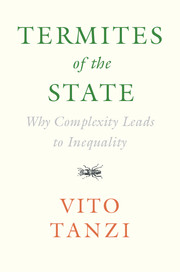- Type
- Chapter
- Information
- Termites of the StateWhy Complexity Leads to Inequality, pp. 401 - 426Publisher: Cambridge University PressPrint publication year: 2017
Last updated 10th July 2024: Online ordering is currently unavailable due to technical issues. We apologise for any delays responding to customers while we resolve this. For further updates please visit our website https://www.cambridge.org/news-and-insights/technical-incident



